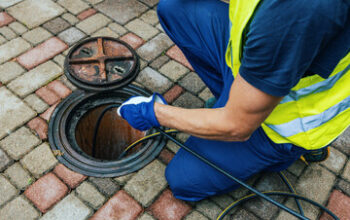Plumbing is the art of transporting and conveying liquids for a wide variety of purposes. Pipes, plumbing fixtures, valves, and other apparatuses do this.

The drain-waste-vent (DWV) system is an essential component of the home plumbing system. It is responsible for removing wastewater from homes and commercial buildings while venting hazardous gases outside the building.
A DWV system can be installed separately or as part of a building’s overall plumbing system. These systems allow for easy maintenance and repairs. They also prevent harmful odors from entering a building.
A properly functioning DWV system will flow water, gases, and solids. However, improper installation can cause recurring clogs and overflows. This is especially true for floor drains, which take in more waste than sinks. In some cases, a clog can be found in a branch line or in the main waste-vent stack. If a clog is located in the DWV, it may require hydro-jetting or a camera to find the problem.
The drainage pipe system for a home consists of a network of vent pipes and fixtures. Vents are located on the roof and behind the walls. Each drain must have at least one or more vents, and each fixture must have its own trap.
Drain-waste-vent (DWV) systems are typically installed in new and old facilities. They are designed to remove waste and odors from buildings while also venting noxious gases. Without these vents, waste would flow poorly, and noxious gases could enter the home.
Properly installed DWV systems will carry waste to the septic tank. However, if the vent is not working, a clog can occur. To remove the clog, a professional can use hydro-jetting or a small camera.
Globally, the market for drain-waste-vent (DWV) piping is expected to grow at an average annual rate of 11% from the year 2020 to 2027. This growth is driven by rising demand for energy-efficient products and government regulations.
Galvanized steel potable water supply and distribution pipes are one of the most common types of pipes. They are made of steel coated with zinc to prevent rusting. This elongates the life of the pipes.
The zinc coating can be either electro-galvanized or dipped. The former is a thinner coat than the latter. Either way, the zinc coating will add a small amount of lead to the metal. Regardless, it’s a good idea to test your system for lead.
If you have lead in your tap water, you should immediately turn to bottled water. Lead is a toxic element and can lead to a number of health concerns. These include chills, muscle aches, and reproductive system disruption. You may also experience a high fever.
The first thing to do when you suspect your water might contain lead is to have a plumber look at your plumbing. He can diagnose the source of the leak and make necessary repairs.
It’s important to note that your home may still have galvanized steel pipes if it was built prior to 1980. However, if your house is older, it’s best to test the water supply. Some states have taken steps to ensure that your tap water is safe.
One of the reasons why you might want to replace your galvanized pipes is that they could be releasing lead into the water. Depending on the size of your home and the location where the pipe is located, this might occur. When lead corrodes from the inside of the pipe, it can release lead into the water.
You can avoid these problems by ensuring that your galvanized pipes are in top shape. Performing periodic maintenance and checking for leaks is important to ensure that you are getting the most out of your system.
If you’re looking for a new plumbing system, you might want to consider PEX pipes. These flexible tubes are available in many different colors and lengths and can be used for both hot and cold water. They also come in long sections, making them easier to handle for DIYers.
One of the biggest advantages of using PEX pipes is that they are resistant to corrosion and pitting. In addition, they can be installed under concrete slabs. Additionally, they are a popular choice for heated floors.
However, there are some drawbacks. For example, PEX can produce toxic chemicals at low levels. Also, they can react with chlorinated water. And they can be damaged by sunlight. Plus, they can be more susceptible to pest damage than metal pipes.

